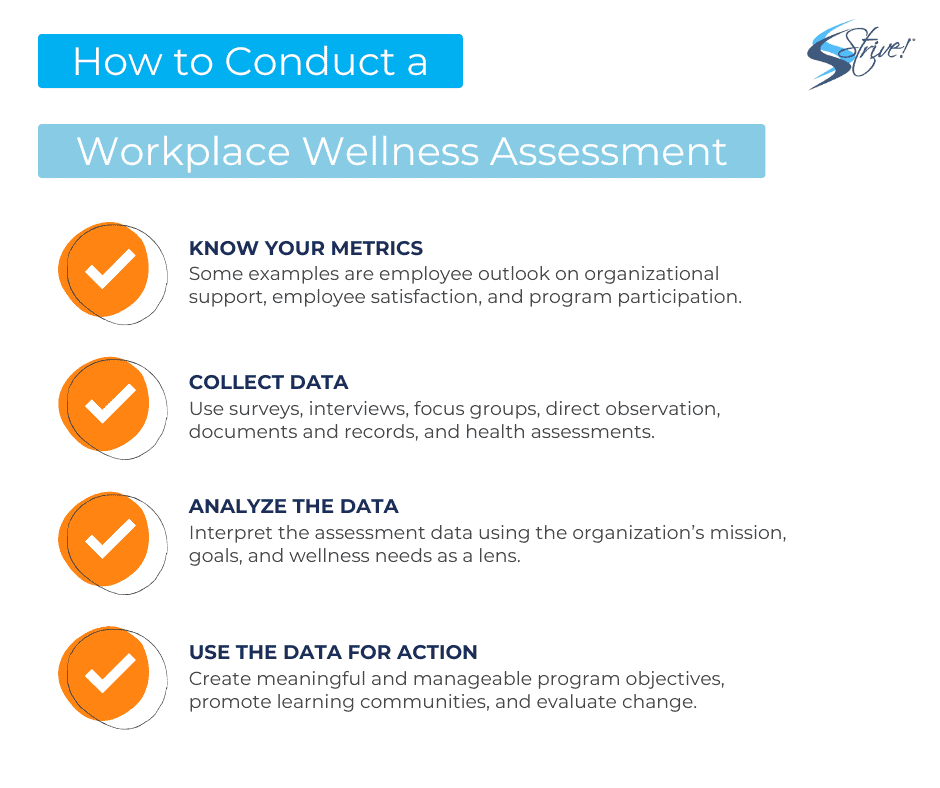How-To Conduct a Workplace Wellness Assessment
In the post-pandemic job market, 61% of job seekers prioritize their personal well-being when searching for job opportunities, with 58% of companies offering a wellness program to attract new talent. But are all wellness programs equally effective at supporting employee well-being?
While consistent data collection is critical in measuring program success, a workplace wellness assessment can capture the program’s impact on a multi-level approach. Organizations that take a holistic or an outcomes-based approach to their wellness programs will benefit from a workplace wellness assessment to understand how their program is serving the population.
Today we’re discussing how to conduct a workplace wellness assessment. By starting with a discussion with key stakeholders, an organization can define its wellness program’s metrics for success. Those specific metrics determine what data must be gathered for analysis to drive positive change in the wellness program.
3 Steps to Conducting a Workplace Wellness Assessment
In this post:
1. What is a Workplace Wellness Assessment?
2. Know What Metrics to Measure for a Workplace Wellness Assessment
3. Collecting Data for a Workplace Wellness Assessment
What is a Workplace Wellness Assessment?
A workplace wellness assessment, or employee survey, measures the current state of employee well-being and the effectiveness of the organization’s wellness initiatives. These assessments are conducted on an annual or biannual basis.
While the wellness assessment is not a step-by-step guide to creating a wellness program, all organizations can benefit from conducting a wellness assessment, regardless of having a developed wellness program.
A wellness assessment is also not a comparison tool. Each workforce is unique and requires strategies specifically designed to address the organization’s needs. Adopting another organization’s wellness program may not be feasible due to budget limitations, workforce-specific needs, and the organization’s prioritization of wellness initiatives.
Know What Metrics to Measure for a Workplace Wellness Assessment
It is critical for organizational stakeholders to decide on what metrics should be measured within the wellness assessment. Most importantly, upper leadership needs to be involved in determining these metrics to ensure the wellness program has continued leadership support. This promotes accountability and sets expectations.
We wrote an article on implementing a wellness program and the importance of leadership buy-in.
Working with leadership also has the added benefit of generating common language when communicating wellness program updates and expected outcomes.
Valuable metrics every organization should consider measuring:
- Employee outlook on organizational support across the eight pillars of wellness through wellness initiatives
- Employee satisfaction with employee benefits, policies, and wellness programming
- Wellness program participant demographics
In all likelihood, leadership will be interested in metrics that fall into the lag measure category. These metrics indicate the wellness program’s current performance, such as health claims data or attendance.
It will be up to the wellness implementation team, be it HR or a dedicated wellness team, to articulate the importance of any additional lead measures that will drive performance data.
Without defining lead measures, the organization will likely lose focus and experiment with wellness solutions that may not serve its workforce needs, which can be costly in both time and resources. Lead measures prioritize what needs to be developed within the wellness program and the resources required.
For example, an organization focused on reducing healthcare claims without considering increasing employee participation over their lifetime at the company may implement an incentives-based wellness program to increase participation. An organization that valued lifetime participation would consider the scalability of an incentives-based wellness program and alternative engagement solutions.
Collecting Data for a Workplace Wellness Assessment
After an organization identifies the success metrics, it is time to start collecting the data. There are different data collection modalities that can be incorporated into a wellness assessment.
The six modalities are:
- Surveys
- Interviews
- Focus Groups
- Direct Observation
- Documents & Records
- Health Assessments & Biometric Screenings
Note: You don’t have to employ every modality. What is useful is to inventory your available data and determine if the organization requires additional information to understand the wellness program’s ability to meet the performance goals.
Employee Surveys
Think of surveys as questionnaires that participants can fill out on their own without needing an interviewer. Surveys are helpful in collecting a large amount of data in a short period of time, are easily administered, are self-service, and are less resource-intensive than the alternate data collection methods.
Here are example survey formats that can be useful to incorporate into a wellness assessment depending on the metrics of success:
- Needs & Interest Survey – for determining the most important wellness offerings the wellness program should provide.
- Employee Engagement Survey – for gauging employee investment in the wellness offerings provided by the organization.
- Health Culture Audit – an annual survey for determining employee perception of wellness outside and within the workplace.
- Attendee Feedback Surveys – day-to-day feedback from attendees regarding specific wellness offerings.
Generally, surveys should be completed on an as-needed basis to not interfere with employee responsibilities. Surveys conducted online and distributed via email simplifies administration.
Interviews
Depending on the goal of data collection, interviews can be conversational and deviate from structured questions. The power of interviews is that the interviewer and interviewee collaborate on collecting the data. This personal approach is helpful for gathering follow-up data, which may not be as easy to obtain from open-ended questions presented in a survey.
Testimonials can be a great interview format for extracting the most value from a structured interview. By asking a series of questions, the interview can gain essential data for improving the wellness program and acquire an asset for promoting the wellness program to stakeholders across the organization.
Focus Groups
Focus groups are another form of collaborative data collection. There are three benefits to conducting focus groups: managing limited resources such as people, money, and time; facilitating breakthrough insights; and getting employee buy-in.
A focus group should have 3-10 participants and a moderator to ensure quality data is gathered. Having too few participants can lead to incomplete data, while having too many individuals can discourage soft-spoken participants from sharing their insights fully.
Though saving resources is a compelling reason for conducting focus groups, the real value comes from the potential breakthrough insights when employees are discussing program initiatives.
While the organization can conduct a focus group for the wellness program as a whole, it is better to use focus groups for generating discussion regarding a specific component of the wellness program. For example, it may be valuable to get feedback from employees regarding mental health initiatives or if they would benefit from one-on-one health coaching services.
Direct Observation
Direct observation of the wellness program can yield insights into the program’s overall performance. However, because direct observation can influence the observed participants, it’s essential to be aware of any potential biasing of the data.
Consider that the wellness program manager audits one of the yoga classes. The instructor might deviate from their usual routine because they are being observed. Even the participating employees may behave differently.
And what happens if the program manager has a soft spot for this particular yoga instructor?
To help maintain objectivity and mitigate an overperformance of the observed actors, the observation should be conducted with minimal interaction and should be focused on the mechanics of the activity.
Additionally, because direct observation is time-consuming, this data collection method should be reserved for collecting qualitative data that has been identified as a high priority by the organization.
Wellness vendors that do QA/QC on their products and services may already be conducting direct observation. Talk to your wellness vendors to see if they can provide the data for your team to evaluate. Alternatively, discussing with your wellness vendors how they’re using their direct observations to improve the services your employees are engaging in can help round out the information you have for your wellness assessment.
Documents & Records
Documents and records are an excellent way to leverage already existing resources to get a clearer picture of the wellness program. Gathering healthcare claims data and wellness platform data from the organization’s vendors is necessary for conducting a workplace wellness assessment.
Strive provides monthly engagement data to clients and an account manager, so an organization does not need to wait to complete a workplace wellness assessment to improve wellness program engagement.
Health Assessments & Biometric Screenings
While employee health assessments and biometric screenings can fall under surveys, documents, and records, pay special attention to this data because of the laws surrounding this sensitive type of information.
While the data will be anonymized and aggregated, there are a few ways to improve the value of the aggregated data to evaluate the wellness program. First, plan to encourage the participants to complete an assessment in the future to track progress. Second, collect a few additional data points related to their participation in the organization’s wellness program. Third, identify which demographics are considered low-risk, moderate-risk, and high-risk for separating out the data.

Analyzing & Interpreting the Wellness Data
The workplace wellness assessment aims to provide a foundation for future planning and execution of the wellness program. To interpret the assessment data effectively, it is crucial to use the organization’s mission, goals, and wellness needs as a lens for analyzing the data.
The data will reveal the current performance and impact of the organization’s wellness initiatives and its contribution to the wellness culture.
Taking Action with the Wellness Assessment Data
After navigating through the wellness assessment data, it can be tough to know what changes to make to the wellness program first. Wellness vendors can help guide organizations in prioritizing initiatives.
Strive can interpret the wellness assessment data and propose initiatives best suited for the organization. Every organization Strive works with is provided with an account manager that oversees timely program implementation and robust tracking of the program’s success metrics.
As your organization takes steps towards your workplace wellness goals, we can continue working with you to plan for ongoing success through rapid improvement projects, creating meaningful and manageable program objectives, promoting learning communities, and measuring and evaluating change.



